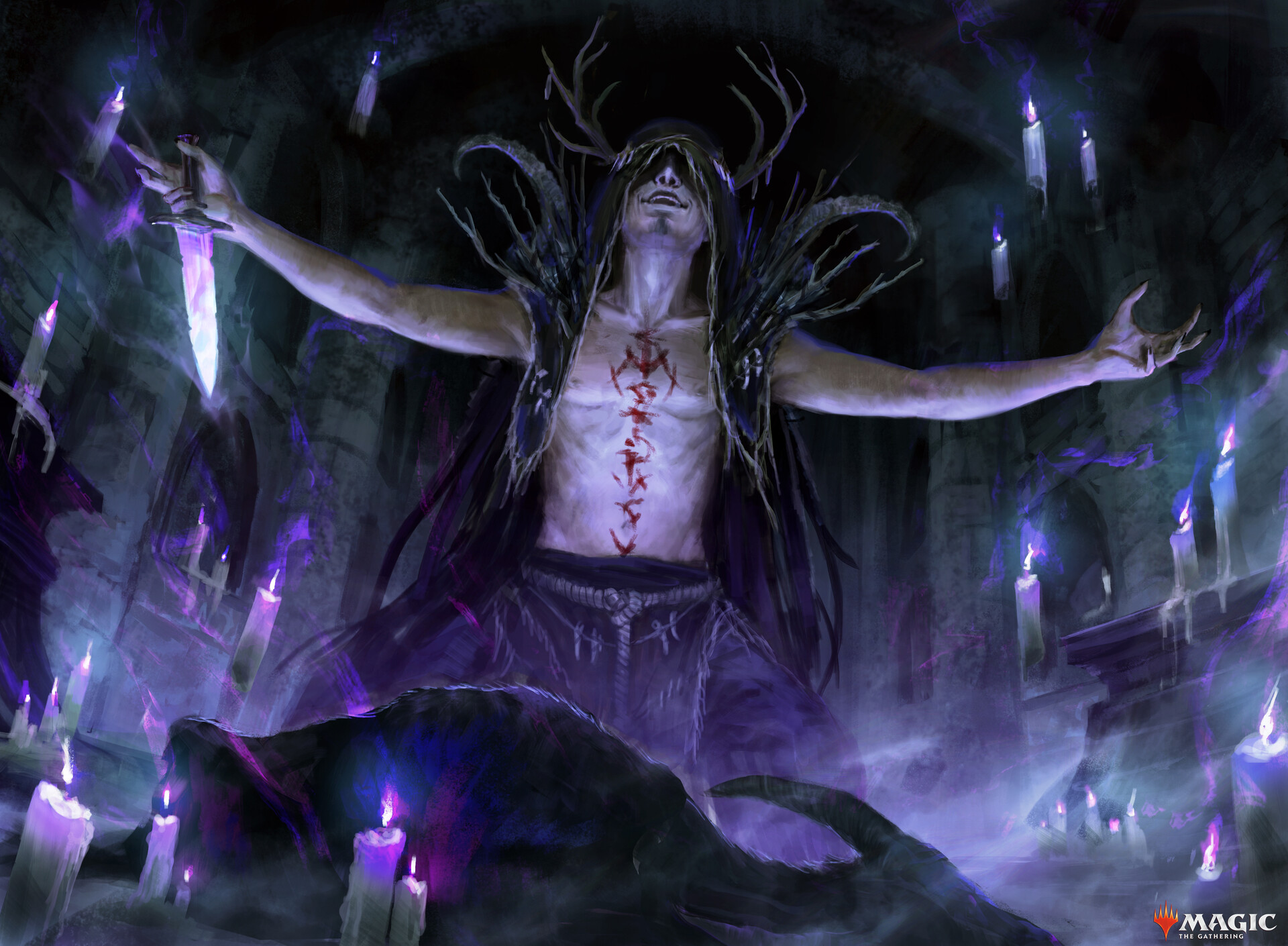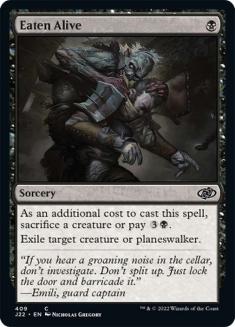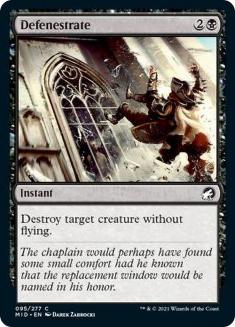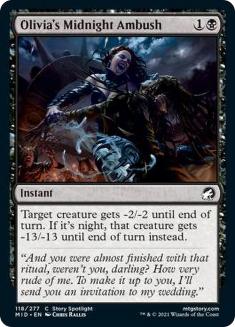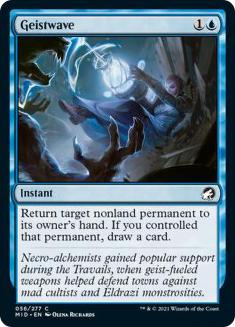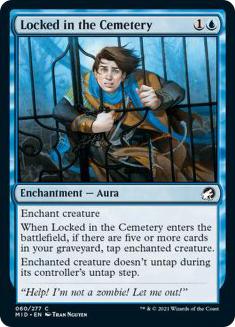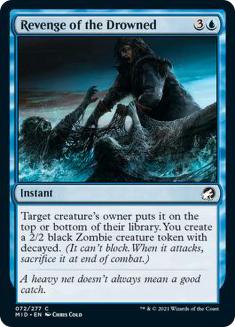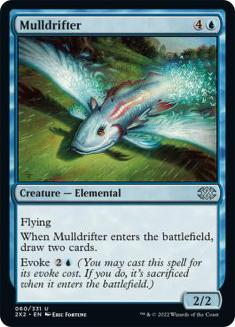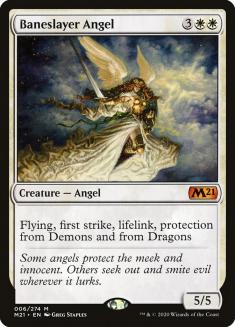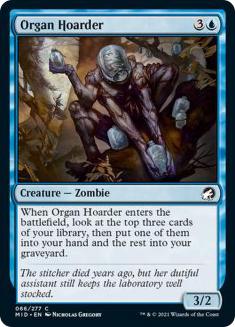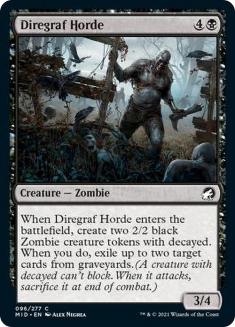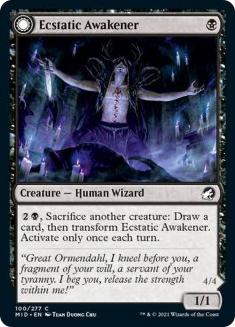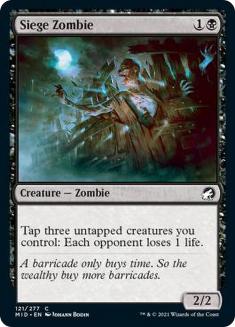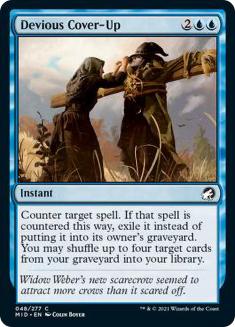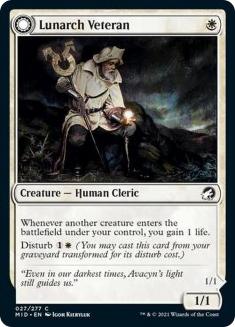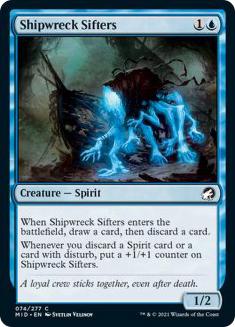In a word…?
Removal
In a sentence…?
The format is driven by an abundance of efficient removal.
To begin our understanding of Innistrad: Midnight Hunt Limited, I’d like to unpack what that means, why it matters, what impact that has, and what it means for the format.
In typical sets, black and red tend to each have three common removal spells. For example, in Adventures in the Forgotten Realms, black had Precipitous Drop, Grim Bounty, and Eyes of the Beholder; red had Improvised Weaponry, Dragon’s Fire, and Farideh’s Fireball. Typically, these removal spells have a range of costs and number of creatures they impact. This trend continues in Innistrad: Midnight Hunt. Black has Eaten Alive, Defenestrate, and Olivia’s Midnight Ambush. Red kind of has four removal spells with Immolation, Neonate’s Rush, Moonrager’s Slash, and Burn the Accursed.
Despite the fact that red has a fourth removal spell, the issue here is really with the black spells. Instead of being spread across a wide curve, with a clunky spell you’d prefer not to play, these cost one, two, and three mana; they all impact a pretty wide range of creatures; and, somewhat critically, they can all kill every Werewolf. In fact, the removal continues in Silver Bolt, which also kills every Werewolf and most other creatures.
Additionally, even blue has Geistwave, Locked in the Cemetery, and Revenge of the Drowned, all of which greatly punish your opponent for taking a turn off to get to night to make a Werewolf large. What I’m getting at is that the format is really punishing of Werewolves in particular, and large creatures in general.
Mulldrifters VS Baneslayers
“Mulldrifters VS Baneslayers” is a useful way to think about what you’re getting when you put a lot of mana into a creature. Are you getting a small creature with some additional value or are you getting a must-answer threat that can win the game on its own? The better the removal is, and the more of that removal can answer any Baneslayer-type creature you might want to play, the weaker those cards are. When there’s less removal, or the removal that exists doesn’t answer larger creatures, Baneslayers are better, because they can just overpower the value you get from a Mulldifter. This set is very far on the Mulldrifter side of the paradigm because the removal is so strong. We see that clearly when looking at Diregraf Horde (62.4% GIH WR on 17Lands.com) compared to Morkrut Behemoth (55.5% GIH WR on 17Lands.com).
Color (im)Balance
This format offers a lot of Mulldrifters because many cards make tokens, have disturbed, draw cards, or otherwise offer some kind of value when they enter the battlefield. However, those cards don’t have even distribution among the colors. Specifically, the only red common that gives you a material advantage when you cast it is Ardent Elementalist. Red cards simply aren’t trying to play the right kind of game (they’re also just independently a little weaker than cards in other colors across the board). The result is that red is the weakest color by a wide enough margin that, according to 17Lands.com, every red archetype wins less than every nonred archetype, a great sign that you should be avoiding a color whenever possible.
To give you an idea of how extreme the situation is, there are nine black commons that have a higher win rate on 17Lands.com than the top red common. That doesn’t exactly mean that they are independently stronger, because they benefit from being played with each other rather than being played with other red cards, but it speaks to how large the gap is. And it’s not just black; there are thirteen blue cards that win more than the top red common, some of which I hope never to have to play. The colors in this format simply are not balanced.
My belief is that black is the strongest color, not just because its removal is strong, though that’s an important piece of the puzzle, and then I think the rest of the colors rank based on how well their cards line up against black. Blue, followed by white, then green, then red. The numbers actually point to blue being more successful than black, and it’s hard to prove that it isn’t stronger, but my intuition is that black is the strongest, but blue is successful in part because it matches up well against black, simply because it has the most and best Mulldrifters, and Mulldrifters beat removal.
Beating Removal
Despite the fact that I think the format is defined by the quality of its removal, or, in fact, arguably because of that, I don’t think the removal spells are the best commons. There’s so much strong removal that you don’t really need to prioritize it. You’ll get some of it, and more importantly, everyone needs to build decks that acknowledge it, which makes it less important. It becomes a victim of its own success. Removal doesn’t definitionally always have to be the best cards in Limited; it’s just that sets are designed in such a way that it often breaks that way. Drafting the SCG Pauper Cube was the clearest example I’ve experienced of a format where traditional removal is actively bad because almost every good creature is a Mulldrifter of some kind.
Organ Hoarder is the common with the highest GIH WR on 17Lands, coming as no particular surprise to Kaldheim players who have seen Sarulf’s Packmate in action. While Organ Hoarder might be the closest card to Mulldrifter, it’s far from the only creature that plays like that.
The best black commons are Diregraf Horde and Eccstatic Awakener (I’m of what I think is the minority opinion that Ecstatic Awakener is actually the best), ahead of all the removal.
If you’re wondering how Ecstatic Awakener can be that good, remember that there are enough cards that make Zombies with decayed that sacrificing a creature is basically free (you can even attack with the Zombie and sacrifice it after damage), and then think about how good a 2BB 4/4 that draws a card is, except you only need one Swamp, you can pay for it over two turns, you can just use it as a one-mana 1/1 for a while, and you can attack for four on Turn 3 sometimes. Also, this is a format where 4/4s are particularly good because the other value creatures mostly have three power or less.
Zombies

If blue and black are the best colors in the set, let’s talk about these Zombie tokens and what they mean for the format. At face value, they mean players start with a lower life total than they would in other formats, as the only thing these tokens can do on their own is attack for two, and sometimes they do that.
My expectation before playing the format was that a bunch of 2/2 tokes would make creatures with three toughness important, but I now don’t think it really plays that way. These creatures don’t really behave like Zombie tropes. They mostly just hang out, and it doesn’t matter if you can block them because they don’t want to attack.
Given that your opponent usually isn’t trying to attack with them, it doesn’t make sense for you to try to block them, which means you should mostly ignore them and attack with your creatures, but that means that your opponent can usually find a window to cash them in for damage if that’s their goal. Even if you try to block, your opponent will generally accumulate several Zombies and then attack with all of them together, so your creature can only block one of them. In general, you shouldn’t go out of your way to try to block the Zombies; you should usually just accept that you have less life to work with in this format.
However, a lot of the time your opponent isn’t even really trying to attack with Zombies. It’s more likely that their goals are to sacrifice them to pay additional costs, to use them to trigger things that care about cards dying, and/or to tap them to use creatures like Siege Zombie, Larder Zombie, or Skaab Wrangler.
Blocking
I mentioned that you don’t want to bother trying to block Zombie tokens, but I’d actually take it a step further. Blocking just isn’t very good in this format in general. Between Siege Zombie, the fact that Zombies generally go so wide, the fact that disturb creatures all have flying, and the strength of removal in the format, attempting to block just isn’t very good. When I’m drafting a control deck, I’m generally looking to be able to acquire “virtual card advantage” by having a single creature that prevents multiple opposing creatures from attacking, so I look for cards like Wishcoin Crab, but that strategy is just completely unreliable in this format. Ways to bypass blockers are all over; even beyond the long list I just gave, coven offers a variety of forms of evasion, and red has cards like Abandon the Post and Lambholt Harrier that prevent blocking.
Strange Intersection
The result of all of this is that we have an aggressive format where creatures are prioritized based on the value they offer beyond their power and toughness rather than the rate charged for power and toughness, which is unusual for aggressive formats, and somewhat counter-intuitive when you think about aggro decks in Constructed that prioritize rate when choosing their creatures.
Seeing the strength of removal and other interaction in blue and black, I immediately drafted a Devious Cover-Up control deck, but I found it wildly unsuccessful. The rate offered for raw card advantage is really bad. Secrets of the Key is just too expensive, so if you want card advantage, you have to look to Organ Hoarder rather than Divination (because no similar card is in the set at common), so when I tried to use spells to contain my opponents’ creatures, they ground me out rather than the reverse.
The fact that so much of the value that’s available in the format is on the battlefield means that cards that offer value without impacting the battlefield, like most flashback spells, are simply too slow. Why pay mana to put something in your hand so that you can pay more mana to put something in your hand when you can just cast a card that replaces itself and then do that again?
Greater Than the Sum of Their Parts
While formats with strong removal are typically lower-synergy because removal breaks up synergies, I think this is still a fairly high-synergy format. You just want to be careful to combine pieces that are independently strong against removal.
A premium example of this is Lunarch Veteran. For people who like to study the 17Lands.com stats as much as I do, a key tell that a card might be a piece of a greater whole rather than an independently strong card is when that card has a high win rate but a relatively low played rate. Sometimes, strong cards are played less than other cards simply because they’re underrated by the community, as we saw early with Vampire Spawn in Adventures in the Forgotten Realms, but sometimes, cards are played at a lower rate because they aren’t generally good, only when combined with specific other cards, as we saw with Price of Loyalty in Adventures in the Forgotten Realms.
I think Lunarch Veteran is more like Price of Loyalty than it is like Vampire Spawn. Without synergies, the 1/1 body is simply too low-impact to play as a card, but if you have Shipwreck Sifters to discard it to or Ecstatic Awakener to sacrifice it to, now you’re getting an extra card out of putting the front side into the graveyard, and the back side gives you a cheap additional threat. When it doesn’t cost you a card and the threat has flying, the value proposition offered by the card is entirely different.
Shipwreck Sifters itself is another card that stands out with similar stats — a disproportionately low rate of play relative to how often it wins. This card is good only if you have a critical mass of Spirits and cards with disturb, which happens almost exclusively in Azorius, where I believe the card is so strong that it contributes substantially to the fact that Azorius has the highest win rate, above Dimir, despite the fact that black is a stronger color than white.
Ecstatic Awakener is another card that follows this trend. Here, I think it’s a combination of the card requiring a certain deck and the card simply being underrated; it does require a certain kind of deck, but people underestimate how easy it is to meet those conditions and how much it’s worth working to make it work. That said, it can be hard to use in Rakdos or Golgari decks, and probably shouldn’t be treated as a top common in those archetypes.
There are other synergies built into the set that I think don’t work as well. The “spells matter” theme in Izzet simply feels underpowered to me, for example, while the Golgari death/recursion theme just seems relatively unimportant — the cards are fine, but you don’t get much mileage out of combining them in particular ways. The Rakdos “deal damage” theme is similar — it’s pretty flexible, so it doesn’t ask a lot in terms of specific cards, but it also doesn’t offer a lot, and it mostly feels like it’s just introducing a point of failure. Your deck stops working if you can’t damage your opponent more than it feels turbo charged if you can.
Playing on Arena
I’ve played this set exclusively in Mythic ranked Best-of-One on Arena. Because players on Arena draft in pods that aren’t paired by skill and play against opponents that are paired by skill, the result is that at Mythic rank you play against the best decks way more often than you play against the worst decks, as the stronger players in the drafts avoid taking the weaker colors and you never get paired against the weaker players who end up in those colors. As a result, my experience is informed by playing against decks composed of Esper colors far more than I play against red decks, and in general, the Arena Mythic format will be shaped more by the best cards and decks than drafts that feature in pod play will be.
If you’re drafting against skilled players and playing in pod, there’s a lot more value to figuring out how to use red cards; if you’re drafting on Arena, especially Best-of-One drafts, you’re likely better off going out of your way to avoid red entirely. I believe all the concepts about the nature of the format still apply, but playing high-ranked Arena matches helps highlight what’s happening among the most successful decks in particular.

